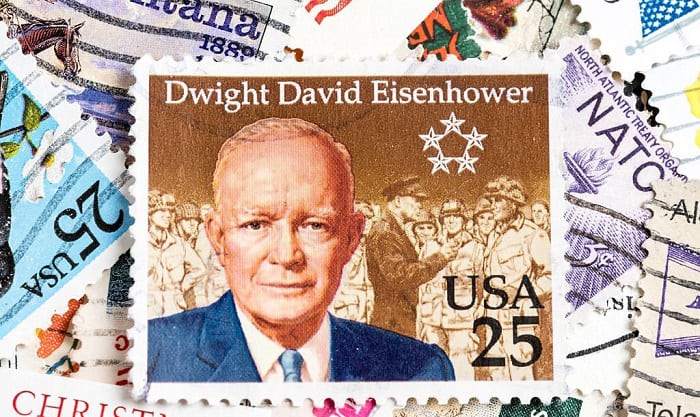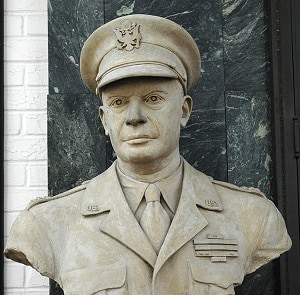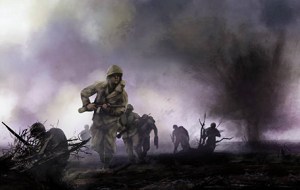What two important military appointments were given to Eisenhower? The short answer is Commander of (SHAPE) Supreme Headquarters Allied Expeditionary Force and Commander of (SACEUR) Supreme Allied Commander Europe.
But there is more detailed information that is worth uncovering. So, continue reading.
Background Context
Table of Contents
Who is Dwight D. Eisenhower?
Fast Facts
- Birth Date: October 14, 1890
- Birth Place: Denison, Texas
- Death Date: March 28, 1969 (At the age of 78)
- Death Place: Washington, D.C
- Resting Place: Presidential Library, Museum and Boyhood Home
What War did General Eisenhower Fight In? – Brief of Eisenhower’s Military Career
Eisenhower took the oath as a cadet in 1911 at the U.S Military Academy at West Point. Upon graduating in 1915, he was commissioned as a second lieutenant in the U.S Army.
Eisenhower was assigned to Fort Sam Houston in the 19th Infantry Regiment and entered World War I on the Continental side.
Eventually, he became brevet lieutenant colonel and commanded a unit in the National Army. His unit drilled tank crews at Camp Colt at “Pickett’s Charge” on the Gettysburg battleground.
He was awarded a Distinguished Service Medal but was disappointed that he missed out on the warfront and combat duty.
Following the war, Eisenhower returned to his regular captain rank, but was promoted to major a few days later. From there, he had several assignments (to name a few):
- 1919 – Test vehicles and work to improve road networks at a transcontinental Army convoy
- Until 1922 – Command a battalion of tanks at Camp Meade, Maryland
- 1920 – Served under generals Fox Conner, John Pershing, Douglas MacArthur, George Marshall
- He became executive officer to General Conner and served until 1924
- He studied at the Command and General Staff College from 1925 to 1926.
- Until 1927, he served as a battalion commander at Fort Benning, Georgia.
- 1928 – He graduated from the Army War College.
- From 1929 to February 1933, he served as executive officer to General George V. Moseley.
- 1933 – He graduated from the Army Industrial College i. Washington, D.C.
- He then was posted as chief military aide to General Douglas MacArthur, Army Chief of Staff.
- 1932 – He took part in the Bonus March encampment clearing in Washington, D.C. l
- 1935 – He went with MacArthur to the Philippines and served as assistant military adviser to the Philippine government.
- December 1939 – He came back to the United States and became the 1st Battalion, 15th Infantry Regiment commanding officer at Fort Lewis, Washington.
- March 1941 – He became a colonel and chief of staff of the new IX Corps under Major General Kenyon Joyce.
- June 1941 – He became the chief of staff to General Walter Krueger, who was the Commander of the Third Army, at Fort Sam Houston in San Antonio, Texas.
- October 1941 – He became brigadier general after partaking in the Louisiana Maneuvers.
1. World War II
- He became the General Staff in Washington after the Japanese attack on Pearl Harbor and served until June 1942.
- Eisenhower was tasked with creating the major war plans against Japan and Germany.
- He was in charge of the Pacific Defenses as Deputy Chief under the Chief of War Plans Division (WPD) General Leonard T. Gero.
- Eventually, he succeeded General Leonard T. Gerow as Chief of the War Plans Division.
- Afterward, he became Assistant Chief of Staff. In this position, he was responsible for the Operations Division that replaced WPD. He was under General George C. Marshall, who was the Chief of Staff.
- End of May 1942 – He went with Lt. Gen. Henry H. Arnold, who was the commanding general of the Army Air Forces, to London. There, they assessed the effectiveness of the theater commander Maj. Gen. James E. Chaney in England.
- June 1942 – He came back as the Commanding General of the European Theater of Operations.
- A month later, he was promoted to lieutenant general.
- November 1942 – He became the Supreme Commander Allied Expeditionary Force of the North African Theater of Operations (NATOUSA) via the new Headquarters Allied (Expeditionary) Force Headquarters (A(E)FHQ).
- February 1943 – His command of AFHQ extended to include the British Eighth Army across the Mediterranean basin, and he played a key role as British and American forces moved through Italy in 1943.
- December 1944 – He became General of the Army. In this command, he showed his great talents for diplomacy and leadership and won the respect of many despite never having seen action.
Eisenhower’s command in WWII was not the end, though.
2. After the World Wars
- After the Germans surrendered, he became the American occupation zone military governor
- He ordered crews to document evidence of Nazi concentration camps for the Nuremberg Trials
- He reclassified German POWs so they were no longer subject to the Geneva Convention
- He also arranged food and medical equipment to be distributed to German civilians
All his actions echoed the new American view that Germans were Nazi victims and the villains were just the ex-Nazis.
- November 1945 – He replaced Marshall as Chief of Staff of the Army to demobilize soldiers
President at Columbia University and NATO Supreme Commander
- 1948 – He became President of Columbia University
- He became the U.S Secretary of Defense’s adviser on the armed forces unification
- He then became the informal Chairman of the Joint Chiefs of Staff in Washington
- December 1950 – He became the Supreme Commander of the North Atlantic Treaty Organization (NATO) and was given operational command of NATO forces in Europe
3. Presidential Campaign of 1952
- June 1952 – After a lot of convincing, he resigned his command at NATO to campaign as President full time
- He defeated Taft for the nomination with his campaign “I Like Ike”
- He defeated Adlai Stevenson II (his Democratic candidate), marking the first Republican return in 20 years
4. Election of 1956
- November 1956 – He successfully ran for re-election
5. Presidency (1953 – 1961)
- He ran against Adlai Stevenson again and won again
Eisenhower’s 2 Most Important Assignments
1. Commander of Supreme Headquarters Allied Expeditionary Force (SHAEF)
The SHAEF is the headquarters of the Commander of Allied Forces in Northwest Europe. It was founded in 1943 and remained active until 1945.
It commanded formations on the Western Front with various forces, including the American and French Army of Liberation and the British and Canadian Army. In addition, SHAEF commanded Allied airborne forces and two tactical air forces. More specifically:
- The First Allied Airborne Army
- The British 21st Army Group
- The 1st Canadian Army & 2nd British Army
- The American 12th Army Group
- The 1st, 3rd, 9th, and 15th United States Army
- The American 6th Army Group
- The French 1st Army & 7th United States Army
- The US Ninth Air Force
- The RAF Second Tactical Air Force
Dwight D. Eisenhower, then General of the Army, assumed the most senior position of SHAEF: Supreme Allied Commander. In this position, he planned and led many invasions, including that of Normandy in France. Today, we look back at it as “D-Day.”
He was charged in these positions with planning and carrying out the Allied assault on the coast of Normandy in June 1944 under the code name Operation Overlord, the liberation of Western Europe and the invasion of Germany.
Eisenhower’s appointment was the result of a stable military ascent, starting with his command of all US troops in the Second World War European theater in 1942.
2. Commander of Supreme Allied Commander Europe (SACEUR)
This is the North Atlantic Treaty Organization’s (NATO) Allied Command Operations (ACO) commander. It is based in Casteau Belgium. Within NATO, SACEUR secures the second-highest military position in terms of precedence. Hence, it is just below the Chairman of the NATO Military Committee.
Eisenhower became SACEUR’s commander in December 1950. After assuming this role, he activated the Supreme Headquarters Allied Powers Europe (SHAPE) and formed a separate staff. He was in office for about 1 year.
During this time, he was also authorized by President Harry Truman to command all of the US forces in the theater.
Conclusion
As you have read this article on what two important military appointments were given to Eisenhower, Eisenhower’s two critical appointments are Commander of SHAEF and Commander of SACEUR. The former was after serving as the commander of U.S forces in Europe, while the latter was in December 1950.

I am Everett Bledsoe, taking on the responsibility of content producer for The Soldiers Project. My purpose in this project is to give honest reviews on the gear utilized and tested over time. Of course, you cannot go wrong when checking out our package of information and guide, too, as they come from reliable sources and years of experience.



